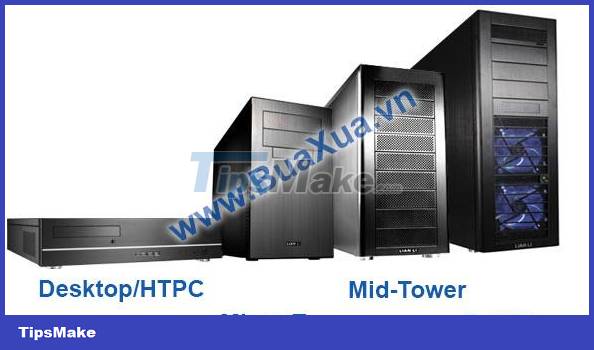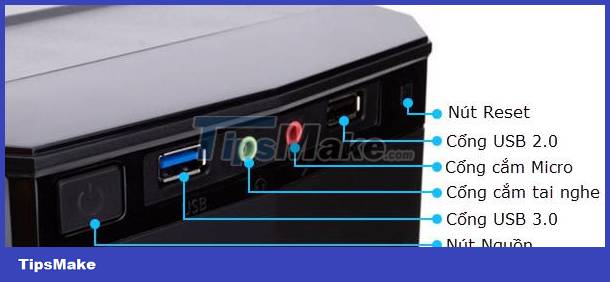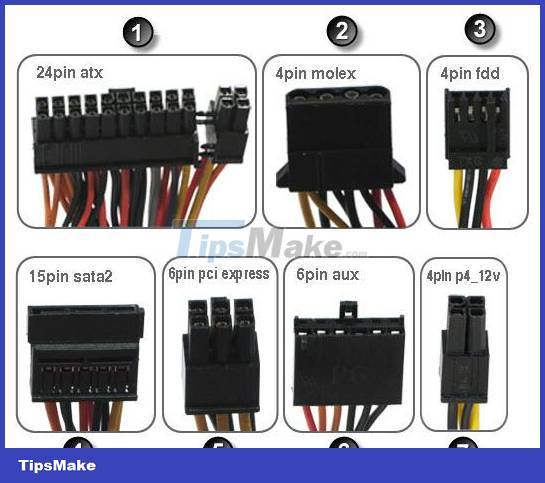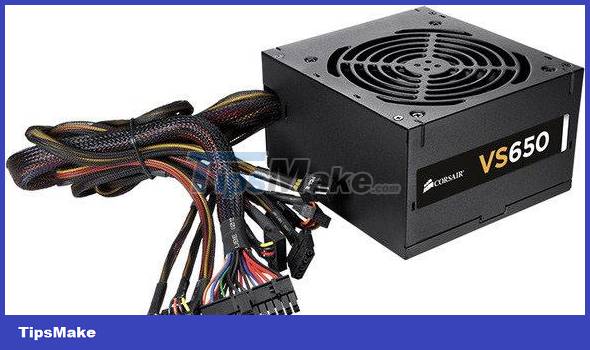Choosing a case and a power supply for a computer
Computers are often evaluated first by their appearance, although it is a mistake, it is advisable to equip a computer with a beautiful, sturdy case and with a good power supply because they will contribute to the stable operation of the entire system.
Computer case
Case is made of metal, used to store parts and equipment of computers. Cases are often chosen by feeling, but expensive cases will be built more sturdily and accurately.
Shape and size of computer case
-
Case has many different colors and sizes to match the size of motherboards.
- Case has type to stand (Tower) and type to lie (Desktop). Cases to lie down often have tight space, sometimes just enough to fit 1 HDD and 1 CD/DVD-ROM.
- Currently, the vertical case type is more popular because computers use many drives and expansion cards, so they have a large capacity, using a standing case with a spacious and airy space will help to cool down better.
 Choosing a case and a power supply for a computer Picture 1 Cases are available in different sizes
Choosing a case and a power supply for a computer Picture 1 Cases are available in different sizes
- Desktop/HTPC: Horizontal type of chassis. This type of case is compact, can be placed on a desk, and is usually placed on top of the screen. This case is suitable for small motherboards such as Micro-ATX and Mini-ATX.
- Micro-Tower: Type of case for standing. This type of case is compact, can be placed on the desk or below. This case is suitable for small motherboards such as Micro-ATX and Mini-ATX.
- Mid-Tower: Type of case to stand. This type of case is larger than the Micro-Tower, which can be placed on a desk or below. This case is suitable for medium sized motherboards such as ATX and Micro-ATX.
- Full-Tower: Type of case to stand. This type of case is the largest, but it can also be placed on a desk or underneath. This case is suitable for large motherboards such as EATX and ATX
Small motherboards can fit into larger sized cases, but large motherboards cannot fit into smaller sized cases.
Buttons and ports on the computer case
 Choosing a case and a power supply for a computer Picture 2 Buttons and ports on the computer case
Choosing a case and a power supply for a computer Picture 2 Buttons and ports on the computer case
-
The case usually has power On/Off buttons (Power, On/Off), restart button (Reset), front USB and audio ports (Micro, Headphone), power indicator, activity indicator of the device. hard disk drive (HDD).
-
Large cases are often equipped with additional fans to help cool the computer.
- In addition, some Cases have decorative colored lights, time clocks, temperature clocks.
- Computer cases are sold with screws to help secure the motherboard and components to the case.
How to choose a computer case?
- If you use a large Mainboard or assemble many devices inside, you should choose a large case to have enough space for installation.
- If using high-speed CPU and high-power components, the case must have additional fans on the side or rear for ventilation.
- The case for lying down is compact, but usually has just enough room for the minimum necessary components and often does not have the ability to expand further.
- If you use an external SATA drive (HDD/CD Box), choose a case with a SATA External connector located in the front for ease of use (This port must also be found on the Mainboard).
- Expensive high-end cases have thicker and heavier cases than regular cases.
See instructions on how to choose a motherboard for your computer for motherboard sizes.
Computer power supplies
- The power supply unit of a computer (Power Supply Unit, abbreviated as PSU) is the part that supplies power to all equipment inside the computer. The power supply converts alternating current (AC) to direct current (DC) with different stable voltage levels to provide power for computer equipment.
- A good power supply, high capacity and stable voltage will help the computer work well, without 'hanging' or shutting down suddenly due to overload.
 Choosing a case and a power supply for a computer Picture 3 Power Supply (Power Supply)
Choosing a case and a power supply for a computer Picture 3 Power Supply (Power Supply)
Power of the computer power supply
- The power of the power supply (Power), unit is Watt (W), is calculated based on many aspects: Power supply, power consumption and maximum power. in which the efficiency of the power supply must be taken into account. The source is often not stated on the label or is not clearly stated, you need to pay attention to these parameters.
- Manufacturers often announce the capacity of the power supply is how many Watt. A power supply with a larger capacity is capable of delivering more power. Desktop power supplies range from 200 watts to 1800 watts (high-end power supplies for servers, dedicated computers, etc.). and this is the rated power.
- Power consumption is the power consumed by a computer power supply with a household power supply.
- The power supplied by the power supply is calculated as the total power that the power supply supplies to all operating devices. The power supplied depends on the quantity and the working status of the equipment. The power supplied is usually less than the maximum power of the power supply.
- The maximum power of a computer power supply is the power achieved in a short time.
- Continuous power is the maximum power that the power supply can achieve when working continuously for a long time.
-
The performance of a computer power supply is determined by the difference between the power supplied and the power consumed by the source. Good computer power supplies usually have an efficiency of over 80%. The tested power supply, if it achieves over 80% efficiency, will be labeled "Green product - environmental protection" or in accordance with the "80+" standard.
Unlike conventional electrical devices, computers have a capacity that varies according to different times and working modes. The important number is therefore continuous rather than peak power, as the power supply unit can operate at peak power for only a short period of time.
Common plug types of computer power supplies
 Choosing a case and a power supply for a computer Picture 4 Common plug types of computer power supplies
Choosing a case and a power supply for a computer Picture 4 Common plug types of computer power supplies
- Detachable 24-pin connector (20 + 4) to fit different motherboards.
- Plugs for IDE/ATA drives (HDD, CD/DVD-ROM, .)
- Plug for floppy drive.
- Plugs for SATA drives (HDD, CD/DVD-ROM, .)
- Plugs for standard PCI Express Cards (Video Cards, .)
- 3.3V and 5V plugs for some motherboards.
- 12V connector for motherboards P4.
Guarantee
- Power supplies are generally warranted for at least 12 months (1 year) according to the manufacturer's conditions.
* Some cases come with a pre-installed power supply, you can negotiate with the seller to exchange another suitable power supply.
* High-power special power supplies for high-end systems sold separately.
Notes when choosing a power supply
- The power supply is the last selected part after calculating the capacity of all devices and components to be used. Then based on the above parameters to choose a power supply with appropriate capacity.
- The capacity of the power supply must at least fully meet the requirements of the computer's equipment, but the capacity of the power supply is always added to ensure stable operation of the computer and can be upgraded later. This.
- Most power supplies will achieve peak efficiency with power delivered between 40% and 80% of rated power. Selecting a power supply with a power supply between 50% and 60% is necessary for maximum efficiency and with room left over for future expansion.
- If you cannot calculate the power supply, keep in mind that typically for computers used in office work, a power supply with a capacity of about 250W to 350W is sufficient, while computers with Using a high-speed processor with a discrete graphics device (VGA Card) attached may require a 450W or larger power supply.
- The power supply must have connectors compatible with the Mainboard and have all the power cords for other devices and components such as disk drives and expansion cards,.
The majority of power supplies in self-assembled computers currently on the market are low or medium quality sources. The efficiency of these sources is only less than 50 - 70%, which means that if this power supply is listed as 300W, it actually only provides about 150W - 210W.
You should read it
- How to assemble an ATX power supply for a computer
- 4 things to note before choosing to buy a PSU power supply for a PC
- Top 5 PC cases worth buying 2019
- How to Check a Power Supply
- How to Test a PC Power Supply
- The difference between a mid tower and a full tower computer case
- Computer power source: More important than you think
- How to choose the best fan case for your PC
- This young man made a computer case with a tube of water, only costing 100,000 VND
- 5 things to know when buying computer power supplies
- 'Tips' check old desktop and case before buying
- CASE function in SQL Server (part 1)
May be interested

How to assemble an optical drive for a computer

How to assemble a hard drive for a computer

How to assemble the Mainboard into the computer case

How to assemble memory into the mainboard of a computer

How to assemble the CPU into the mainboard of the computer

How to assemble an ATX power supply for a computer







 4 things to note before choosing to buy a PSU power supply for a PC
4 things to note before choosing to buy a PSU power supply for a PC Which computer power supply brand is good? Choosing the right PSU
Which computer power supply brand is good? Choosing the right PSU How to Check a Power Supply
How to Check a Power Supply 8 best PSUs of 2019
8 best PSUs of 2019 How to assemble an ATX power supply for a computer
How to assemble an ATX power supply for a computer Computer power source: More important than you think
Computer power source: More important than you think